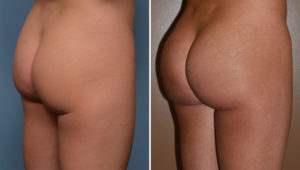Background: Buttock implants offer a method of buttock augmentation when one has inadequate fat to harvest. It has become more popular over the past decade than ever before as the patient demand for buttock augmentation has risen dramatically. But unlike fat transfer there are multiple considerations when buttock implants are considered. These include size, shape and implant location.
The biggest consideration in using buttock implants is whether they should be placed above (subfascial) or into the muscle. (intramuscular) Each implant location has its own advantages or disadvantages. The intramuscular location offers the lowest risk of long-term implant complications but the longest after surgery recovery. Its other ‘disadvantage’ is that the implant size will be more limited. The intramuscular pocket does not allow for much bigger implants than about 350ccs of volume. This us unlike the subfascial location where much larger buttock implants can be placed.
Case Study: This 26 year-old female wanted a larger buttocks but knew she did not have enough fat to get a good result. She was aware of the concept of subfascial vs intramuscular pockets and wanted the implants placed inside the muscle. She had a flat but moderate-sized buttock shape and preoperative measurements indicated that a 300cc to 350cc implant could be placed.



Highlights:
1) Buttock implants offer a reliable and permanent method of buttock augmentation
2) The intramuscular placement of buttock implants offers the least complications long-term but has a significant surgical recovery.
3) Intramuscular buttock implants have size restrictions and are only indicated in patients that are not eligible for a fat transfer buttock augmentation.
Dr. Barry Eppley
Indianapolis, Indiana



